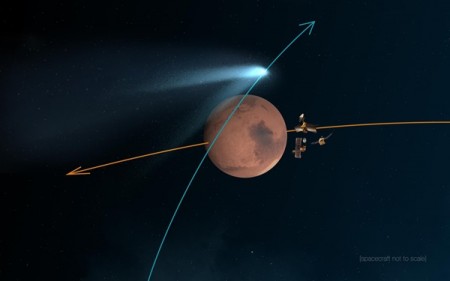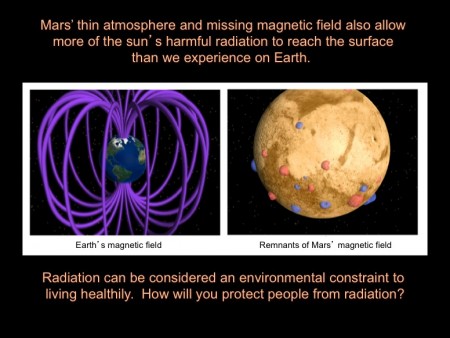March 20, 2016 – Comet Siding Spring flew by Mars on October 19, 2014 giving scientists an opportunity to see the impact of a close encounter with the Red Planet. The Martian orbiters were at risk and NASA and the European Space Agency altered their orbits and shut off instrumentation to protect them from incidental damage (see artist’s illustration showing the lining up of the orbiters behind the planet to shield them). One NASA satellite, Mars Atmosphere and Volatile Evolution (MAVEN), kept a few instruments running including the robotic spacecraft’s magnetometer.
As Siding Spring’s coma passed by the planet it interacted with the magnetic field with consequences for the atmosphere. MAVEN’s magnetometer recorded specific effects including:
- a strong rotation and realignment of the magnetic field as the comet approached
- severe distortion of the Martian ionosphere at the comet’s closest approach
- and strong magnetic turbulence lasting many hours after the comet had passed
Mars’ magnetic field is not like Earth’s. Here we have a strong magnetosphere, the Van Allen Belts. The magnetosphere protects the planet from being bathed in solar and cosmic radiation. Life here would be very different or non-existent without the strong magnetosphere.
Mars on the other hand appears to have been more geologically active in its early history than it is today. From studying the magnetic properties of the crust it appears that over time conditions in the mantle and planetary core have altered. With no internal dynamo equivalent to Earth’s, the Red Planet has seen its magnetosphere weaken to become highly variable and tenuous. A comparison of the two planets can be seen in the image below.
So how could a small comet like Siding Spring with its nucleus measuring less than 0.5 kilometers (about 1/3 of a mile) across, impact the Martian atmosphere? At its closest encounter the comet nucleus passed by at a distance of 140,000 kilometers (87,000 miles). A comet nucleus is not the problem. It’s what the nucleus sheds that is. Called the coma, it is the visible fuzzy ball seen through telescopes, and as it approaches the inner Solar System the coma forms a trailing tail.
Siding Spring’s coma and tail extended almost 1 million kilometers (more than 600,000 miles). The ionized particles within it temporarily merged with and then overwhelmed the planet’s magnetosphere. With the magnetosphere no longer capable of protecting the upper atmosphere, Mars experienced the equivalent to a solar storm interacting with Earth. The temporary surge ripped away some of the atmosphere. One can imagine similar encounters in the past stripping away what was once a much more dense envelope around the planet no longer protected by a significant magnetosphere.
The MAVEN results were recently published in the November 16, 2015 edition of Geophysical Research Letters. The article is entitled “A comet engulfs Mars: MAVEN observations of comet Siding Spring’s influence on the Martian magnetosphere.”










